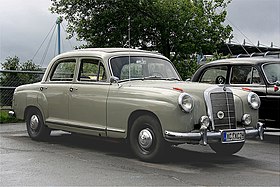| This article needs additional citations for verification. Please help improve this article by adding citations to reliable sources. Unsourced material may be challenged and removed. Find sources: "Mercedes-Benz W105" – news · newspapers · books · scholar · JSTOR (June 2019) (Learn how and when to remove this message) |
| Mercedes-Benz W105 219 | |
|---|---|
 Mercedes-Benz 219 (W105) Mercedes-Benz 219 (W105) | |
| Overview | |
| Manufacturer | Daimler-Benz (saloons) IMA (estates) |
| Production |
|
| Body and chassis | |
| Class | luxury car (F) |
| Body style | |
| Layout | Front-engine, rear-wheel-drive layout |
| Related | Mercedes-Benz W120/W121 — 180 (D) & 190 (D) Mercedes-Benz W180 — 220a/S Mercedes-Benz W128 — 220SE |
| Powertrain | |
| Engine | 2195 cc M180 II I6 |
| Transmission | 4-speed manual, lever on steering column |
| Dimensions | |
| Wheelbase | 2,750 mm (108.3 in) |
| Length | 4,650 mm (183.1 in) from 8–1957: 468 cm (184 in) |
| Width | 1,740 mm (68.5 in) |
| Height | 1,560 mm (61.4 in) |
| Curb weight |
|
| Chronology | |
| Predecessor | Mercedes-Benz W187 |
| Successor | Mercedes-Benz W111 |
The Mercedes-Benz W105 is the internal designation for a four-door executive car, manufactured by Daimler-Benz from 1956 to 1959, and marketed as the Mercedes-Benz Typ(e) 219. The W105 was nicknamed Ponton, along with its Mercedes model siblings, from its introduction, because it employed ponton, or pontoon styling, a defining post-war car design innovation that unified a car's previously articulated bonnet, wings, body and running boards into a singular, slab-sided envelope.
The Mercedes 219 (internally W105), had a 2.2 L inline 6-cylinder engine, and uniquely featured a bodyshell that combined the stretched nose of the more luxury W128 and W180 models 220a and 220 S(E), but shared the regular standard wheelbase cabine, with shorter rear doors, with the 1953 entry-level 4-cylinder Mercedes W120/W121 models 180 and 190, to offer an intermediate no-frills 6-cylinder model option.
History
The body shape had been introduced in 1953 by the W120 chassis 180. In the following year, Mercedes-Benz introduced the 6-cylinder 220a which was visually similar to the 180, but with a 170 mm (7 in) longer wheelbase, and an entirely new rear suspension design. 100 mm (4 in) were added to the front to accommodate the two extra cylinders and 70 mm (3 in) added to the rear doors to provide more legroom for the rear passengers. This model ran until 1956 when the 219 and the 220S were introduced.
It is possible that the introduction of the 219 was due to the state government's introduction of a higher rate of car tax on cars with an engine of 2200ccs or larger. To get round this tax, Mercedes reduced the size of the engine to 2195ccs. Hence the 219 and the 220 co-existed for a short while. When the government announced that the 219 would be taxed as if it was a 220, Mercedes stopped making them.
Model identification
The 219 from the a-pillar forward was identical to the long-nosed 220a, including the single-carburettor 2.2 L 6-cylinder engine. However, from the a‑pillar back, it used the shorter body of the W120/W121 180/190 models — accordingly, wheelbase and total length of the 219 were shorter compared to the 220 S, but bigger compared to the 190. This can be identified by the one-piece windows in the rear doors, as opposed to the 220a and 220S having separate quarter windows.
Inside, the 219 used the simpler instrumentation of the small car, along with bakelite trim instead of woodgrain.
| Model | Years | Chassis code | Engine | Displacement | Power | Built |
|---|---|---|---|---|---|---|
| 219 | 3/56–7/59 | 105.010 105.011 |
M 180.921 / R 6 | 2195 cc | 86 PS (63 kW; 85 hp) | 27,845 |
- Equipped with a Webasto sliding sunroof. The material was referred to as "Covertex" (vinyl).





| Mercedes-Benz | 219 |
|---|---|
| Engine | 6-cylinder-inline engine (four-stroke), front-mounted |
| Bore x Stroke | 80 mm x 72.8 mm |
| Displacement | 2195 cc |
| Max. Power | 86 PS (63 kW; 85 hp) @ 4800 rpm |
| Max. Torque | 157 N⋅m (116 lbf⋅ft) @ 2400 rpm |
| Compression Ratio | 7.6:1 |
| Fuel feed: | Double downdraft carburetor Solex 32 PAATI |
| Fuel tank capacity | 56 L (14.8 US gal; 12.3 imp gal) |
| Valvetrain | SOHC, duplex chain |
| Cooling | Water |
| Gearbox | 4-speed manual, lever on steering column rear wheel drive, standard axle ratio 4.10:1 from August 1957: 3.90:1 |
| Electrical system | 12 volt |
| Front suspension | Double wishbones, coil springs, stabilising bar |
| Rear suspension | Swing axle, coil springs |
| Brakes | Drum brakes (Ø 230 mm), power assisted optional |
| Steering | Recirculating ball steering |
| Body structure | Sheet steel, unibody construction |
| Track front | 1,430 mm (56 in) |
| Track rear | 1,470 mm (58 in) |
| Tire sizes | 6.40 x 13 |
| Top speed | 148 km/h (92 mph) |
| Fuel Consumption (estimate) | 11.2 L/100 km (25 mpg‑imp; 21.0 mpg‑US) |
References
- 219 - Mercedes Database
- ^ "Ponton Mercedes", six-cylinder models (W 180, W 105, W 128), 1954 - 1959 - Mercedes Database
| « previous — Mercedes-Benz road car timeline, 1946–1970s — next » | ||||||||||||||||||||||||||||||||||||||||||||||||||||||||||||||||||||||||||||||||||||||||||||||||||||||||||||||||||||||||||||||||||||||||||||||||||||||||||||||||||||||||||||||||||||||||||||||||||||||||||||||||||||||||||||||||||||||||||||||||||||||||||||||||||||||||||||||||||||||||||||||||||||||||||||||||||||||||||||||||||||||||||||||||||||||||||||||||||||||||||||||||||||||||||||||||||||||||||||||||||||||||||||||||||||||||||||||||||||||||||||||||||||||||||||||||||||||||||||||||||||||||||||||||||||||||||||||||||||||||||||||||||||||||||||||||||||||||||||||||||||||||||||||||||||||||||||||||||||||||||||||||||||||||||||||||||||||||||||||||||||||||||||||||||||||||||||||||||||||||||||||||||||||||||||||||||||||||||||||||||||||||||||||||||||||||||||||||||||||||||||||||||||||||||
|---|---|---|---|---|---|---|---|---|---|---|---|---|---|---|---|---|---|---|---|---|---|---|---|---|---|---|---|---|---|---|---|---|---|---|---|---|---|---|---|---|---|---|---|---|---|---|---|---|---|---|---|---|---|---|---|---|---|---|---|---|---|---|---|---|---|---|---|---|---|---|---|---|---|---|---|---|---|---|---|---|---|---|---|---|---|---|---|---|---|---|---|---|---|---|---|---|---|---|---|---|---|---|---|---|---|---|---|---|---|---|---|---|---|---|---|---|---|---|---|---|---|---|---|---|---|---|---|---|---|---|---|---|---|---|---|---|---|---|---|---|---|---|---|---|---|---|---|---|---|---|---|---|---|---|---|---|---|---|---|---|---|---|---|---|---|---|---|---|---|---|---|---|---|---|---|---|---|---|---|---|---|---|---|---|---|---|---|---|---|---|---|---|---|---|---|---|---|---|---|---|---|---|---|---|---|---|---|---|---|---|---|---|---|---|---|---|---|---|---|---|---|---|---|---|---|---|---|---|---|---|---|---|---|---|---|---|---|---|---|---|---|---|---|---|---|---|---|---|---|---|---|---|---|---|---|---|---|---|---|---|---|---|---|---|---|---|---|---|---|---|---|---|---|---|---|---|---|---|---|---|---|---|---|---|---|---|---|---|---|---|---|---|---|---|---|---|---|---|---|---|---|---|---|---|---|---|---|---|---|---|---|---|---|---|---|---|---|---|---|---|---|---|---|---|---|---|---|---|---|---|---|---|---|---|---|---|---|---|---|---|---|---|---|---|---|---|---|---|---|---|---|---|---|---|---|---|---|---|---|---|---|---|---|---|---|---|---|---|---|---|---|---|---|---|---|---|---|---|---|---|---|---|---|---|---|---|---|---|---|---|---|---|---|---|---|---|---|---|---|---|---|---|---|---|---|---|---|---|---|---|---|---|---|---|---|---|---|---|---|---|---|---|---|---|---|---|---|---|---|---|---|---|---|---|---|---|---|---|---|---|---|---|---|---|---|---|---|---|---|---|---|---|---|---|---|---|---|---|---|---|---|---|---|---|---|---|---|---|---|---|---|---|---|---|---|---|---|---|---|---|---|---|---|---|---|---|---|---|---|---|---|---|---|---|---|---|---|---|---|---|---|---|---|---|---|---|---|---|---|---|---|---|---|---|---|---|---|---|---|---|---|---|---|---|---|---|---|---|---|---|---|---|---|---|---|---|---|---|---|---|---|---|---|---|---|---|---|---|---|---|---|---|---|---|---|---|---|---|---|---|---|---|---|---|---|---|---|---|---|---|---|---|---|---|---|---|---|---|---|---|---|---|---|---|---|---|---|---|---|---|---|---|---|---|---|---|---|---|---|---|---|---|---|---|---|---|---|---|---|---|---|---|---|---|---|---|---|---|---|---|---|---|---|---|---|---|---|---|---|---|---|---|---|---|---|---|---|---|---|---|---|---|---|---|---|---|---|---|---|---|---|---|---|---|---|---|---|---|---|---|---|---|---|---|---|---|---|---|---|---|---|---|---|---|---|---|---|---|---|---|---|---|---|---|---|---|---|---|---|---|---|---|---|---|---|---|---|---|---|---|---|---|---|---|---|---|---|---|---|---|---|---|---|---|---|---|---|---|---|---|---|---|---|---|---|---|---|---|---|---|---|---|---|---|---|---|---|---|---|---|---|---|---|---|---|---|---|---|---|---|---|---|---|---|---|---|---|---|---|---|---|---|---|---|---|---|---|---|---|---|---|---|---|---|---|---|---|---|
| ||||||||||||||||||||||||||||||||||||||||||||||||||||||||||||||||||||||||||||||||||||||||||||||||||||||||||||||||||||||||||||||||||||||||||||||||||||||||||||||||||||||||||||||||||||||||||||||||||||||||||||||||||||||||||||||||||||||||||||||||||||||||||||||||||||||||||||||||||||||||||||||||||||||||||||||||||||||||||||||||||||||||||||||||||||||||||||||||||||||||||||||||||||||||||||||||||||||||||||||||||||||||||||||||||||||||||||||||||||||||||||||||||||||||||||||||||||||||||||||||||||||||||||||||||||||||||||||||||||||||||||||||||||||||||||||||||||||||||||||||||||||||||||||||||||||||||||||||||||||||||||||||||||||||||||||||||||||||||||||||||||||||||||||||||||||||||||||||||||||||||||||||||||||||||||||||||||||||||||||||||||||||||||||||||||||||||||||||||||||||||||||||||||||||||